Pengfei Chen
P2Object: Single Point Supervised Object Detection and Instance Segmentation
Apr 10, 2025Abstract:Object recognition using single-point supervision has attracted increasing attention recently. However, the performance gap compared with fully-supervised algorithms remains large. Previous works generated class-agnostic \textbf{\textit{proposals in an image}} offline and then treated mixed candidates as a single bag, putting a huge burden on multiple instance learning (MIL). In this paper, we introduce Point-to-Box Network (P2BNet), which constructs balanced \textbf{\textit{instance-level proposal bags}} by generating proposals in an anchor-like way and refining the proposals in a coarse-to-fine paradigm. Through further research, we find that the bag of proposals, either at the image level or the instance level, is established on discrete box sampling. This leads the pseudo box estimation into a sub-optimal solution, resulting in the truncation of object boundaries or the excessive inclusion of background. Hence, we conduct a series exploration of discrete-to-continuous optimization, yielding P2BNet++ and Point-to-Mask Network (P2MNet). P2BNet++ conducts an approximately continuous proposal sampling strategy by better utilizing spatial clues. P2MNet further introduces low-level image information to assist in pixel prediction, and a boundary self-prediction is designed to relieve the limitation of the estimated boxes. Benefiting from the continuous object-aware \textbf{\textit{pixel-level perception}}, P2MNet can generate more precise bounding boxes and generalize to segmentation tasks. Our method largely surpasses the previous methods in terms of the mean average precision on COCO, VOC, SBD, and Cityscapes, demonstrating great potential to bridge the performance gap compared with fully supervised tasks.
Language-Guided Visual Perception Disentanglement for Image Quality Assessment and Conditional Image Generation
Mar 04, 2025Abstract:Contrastive vision-language models, such as CLIP, have demonstrated excellent zero-shot capability across semantic recognition tasks, mainly attributed to the training on a large-scale I&1T (one Image with one Text) dataset. This kind of multimodal representations often blend semantic and perceptual elements, placing a particular emphasis on semantics. However, this could be problematic for popular tasks like image quality assessment (IQA) and conditional image generation (CIG), which typically need to have fine control on perceptual and semantic features. Motivated by the above facts, this paper presents a new multimodal disentangled representation learning framework, which leverages disentangled text to guide image disentanglement. To this end, we first build an I&2T (one Image with a perceptual Text and a semantic Text) dataset, which consists of disentangled perceptual and semantic text descriptions for an image. Then, the disentangled text descriptions are utilized as supervisory signals to disentangle pure perceptual representations from CLIP's original `coarse' feature space, dubbed DeCLIP. Finally, the decoupled feature representations are used for both image quality assessment (technical quality and aesthetic quality) and conditional image generation. Extensive experiments and comparisons have demonstrated the advantages of the proposed method on the two popular tasks. The dataset, code, and model will be available.
SAM-CP: Marrying SAM with Composable Prompts for Versatile Segmentation
Jul 23, 2024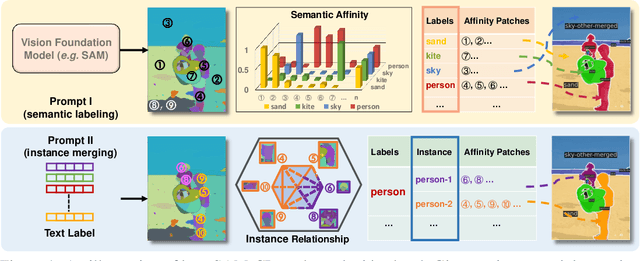



Abstract:The Segment Anything model (SAM) has shown a generalized ability to group image pixels into patches, but applying it to semantic-aware segmentation still faces major challenges. This paper presents SAM-CP, a simple approach that establishes two types of composable prompts beyond SAM and composes them for versatile segmentation. Specifically, given a set of classes (in texts) and a set of SAM patches, the Type-I prompt judges whether a SAM patch aligns with a text label, and the Type-II prompt judges whether two SAM patches with the same text label also belong to the same instance. To decrease the complexity in dealing with a large number of semantic classes and patches, we establish a unified framework that calculates the affinity between (semantic and instance) queries and SAM patches and merges patches with high affinity to the query. Experiments show that SAM-CP achieves semantic, instance, and panoptic segmentation in both open and closed domains. In particular, it achieves state-of-the-art performance in open-vocabulary segmentation. Our research offers a novel and generalized methodology for equipping vision foundation models like SAM with multi-grained semantic perception abilities.
A Survey on Failure Analysis and Fault Injection in AI Systems
Jun 28, 2024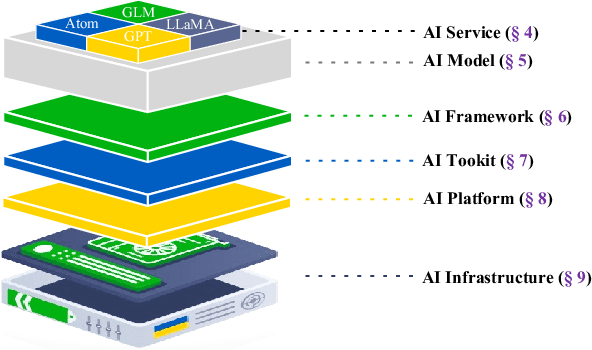
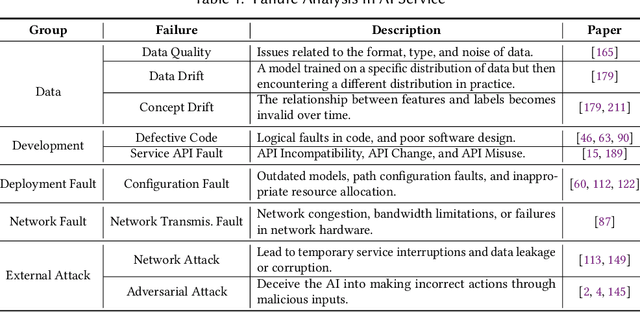
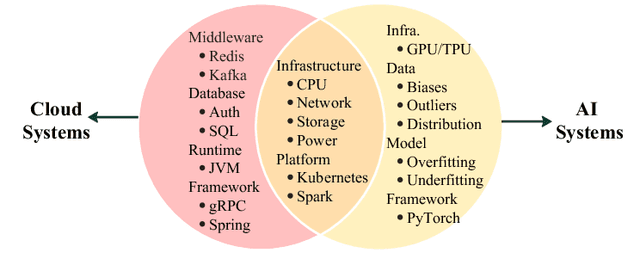
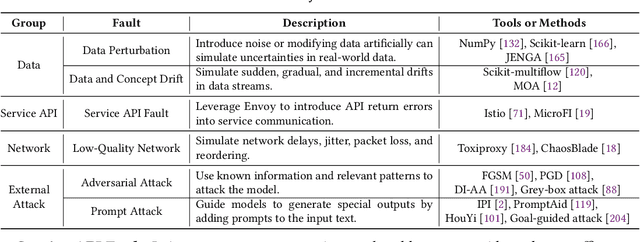
Abstract:The rapid advancement of Artificial Intelligence (AI) has led to its integration into various areas, especially with Large Language Models (LLMs) significantly enhancing capabilities in Artificial Intelligence Generated Content (AIGC). However, the complexity of AI systems has also exposed their vulnerabilities, necessitating robust methods for failure analysis (FA) and fault injection (FI) to ensure resilience and reliability. Despite the importance of these techniques, there lacks a comprehensive review of FA and FI methodologies in AI systems. This study fills this gap by presenting a detailed survey of existing FA and FI approaches across six layers of AI systems. We systematically analyze 160 papers and repositories to answer three research questions including (1) what are the prevalent failures in AI systems, (2) what types of faults can current FI tools simulate, (3) what gaps exist between the simulated faults and real-world failures. Our findings reveal a taxonomy of AI system failures, assess the capabilities of existing FI tools, and highlight discrepancies between real-world and simulated failures. Moreover, this survey contributes to the field by providing a framework for fault diagnosis, evaluating the state-of-the-art in FI, and identifying areas for improvement in FI techniques to enhance the resilience of AI systems.
AesExpert: Towards Multi-modality Foundation Model for Image Aesthetics Perception
Apr 15, 2024Abstract:The highly abstract nature of image aesthetics perception (IAP) poses significant challenge for current multimodal large language models (MLLMs). The lack of human-annotated multi-modality aesthetic data further exacerbates this dilemma, resulting in MLLMs falling short of aesthetics perception capabilities. To address the above challenge, we first introduce a comprehensively annotated Aesthetic Multi-Modality Instruction Tuning (AesMMIT) dataset, which serves as the footstone for building multi-modality aesthetics foundation models. Specifically, to align MLLMs with human aesthetics perception, we construct a corpus-rich aesthetic critique database with 21,904 diverse-sourced images and 88K human natural language feedbacks, which are collected via progressive questions, ranging from coarse-grained aesthetic grades to fine-grained aesthetic descriptions. To ensure that MLLMs can handle diverse queries, we further prompt GPT to refine the aesthetic critiques and assemble the large-scale aesthetic instruction tuning dataset, i.e. AesMMIT, which consists of 409K multi-typed instructions to activate stronger aesthetic capabilities. Based on the AesMMIT database, we fine-tune the open-sourced general foundation models, achieving multi-modality Aesthetic Expert models, dubbed AesExpert. Extensive experiments demonstrate that the proposed AesExpert models deliver significantly better aesthetic perception performances than the state-of-the-art MLLMs, including the most advanced GPT-4V and Gemini-Pro-Vision. Source data will be available at https://github.com/yipoh/AesExpert.
CPR++: Object Localization via Single Coarse Point Supervision
Jan 30, 2024Abstract:Point-based object localization (POL), which pursues high-performance object sensing under low-cost data annotation, has attracted increased attention. However, the point annotation mode inevitably introduces semantic variance due to the inconsistency of annotated points. Existing POL heavily rely on strict annotation rules, which are difficult to define and apply, to handle the problem. In this study, we propose coarse point refinement (CPR), which to our best knowledge is the first attempt to alleviate semantic variance from an algorithmic perspective. CPR reduces the semantic variance by selecting a semantic centre point in a neighbourhood region to replace the initial annotated point. Furthermore, We design a sampling region estimation module to dynamically compute a sampling region for each object and use a cascaded structure to achieve end-to-end optimization. We further integrate a variance regularization into the structure to concentrate the predicted scores, yielding CPR++. We observe that CPR++ can obtain scale information and further reduce the semantic variance in a global region, thus guaranteeing high-performance object localization. Extensive experiments on four challenging datasets validate the effectiveness of both CPR and CPR++. We hope our work can inspire more research on designing algorithms rather than annotation rules to address the semantic variance problem in POL. The dataset and code will be public at github.com/ucas-vg/PointTinyBenchmark.
AesBench: An Expert Benchmark for Multimodal Large Language Models on Image Aesthetics Perception
Jan 16, 2024Abstract:With collective endeavors, multimodal large language models (MLLMs) are undergoing a flourishing development. However, their performances on image aesthetics perception remain indeterminate, which is highly desired in real-world applications. An obvious obstacle lies in the absence of a specific benchmark to evaluate the effectiveness of MLLMs on aesthetic perception. This blind groping may impede the further development of more advanced MLLMs with aesthetic perception capacity. To address this dilemma, we propose AesBench, an expert benchmark aiming to comprehensively evaluate the aesthetic perception capacities of MLLMs through elaborate design across dual facets. (1) We construct an Expert-labeled Aesthetics Perception Database (EAPD), which features diversified image contents and high-quality annotations provided by professional aesthetic experts. (2) We propose a set of integrative criteria to measure the aesthetic perception abilities of MLLMs from four perspectives, including Perception (AesP), Empathy (AesE), Assessment (AesA) and Interpretation (AesI). Extensive experimental results underscore that the current MLLMs only possess rudimentary aesthetic perception ability, and there is still a significant gap between MLLMs and humans. We hope this work can inspire the community to engage in deeper explorations on the aesthetic potentials of MLLMs. Source data will be available at https://github.com/yipoh/AesBench.
Semantic-aware SAM for Point-Prompted Instance Segmentation
Dec 26, 2023



Abstract:Single-point annotation in visual tasks, with the goal of minimizing labelling costs, is becoming increasingly prominent in research. Recently, visual foundation models, such as Segment Anything (SAM), have gained widespread usage due to their robust zero-shot capabilities and exceptional annotation performance. However, SAM's class-agnostic output and high confidence in local segmentation introduce 'semantic ambiguity', posing a challenge for precise category-specific segmentation. In this paper, we introduce a cost-effective category-specific segmenter using SAM. To tackle this challenge, we have devised a Semantic-Aware Instance Segmentation Network (SAPNet) that integrates Multiple Instance Learning (MIL) with matching capability and SAM with point prompts. SAPNet strategically selects the most representative mask proposals generated by SAM to supervise segmentation, with a specific focus on object category information. Moreover, we introduce the Point Distance Guidance and Box Mining Strategy to mitigate inherent challenges: 'group' and 'local' issues in weakly supervised segmentation. These strategies serve to further enhance the overall segmentation performance. The experimental results on Pascal VOC and COCO demonstrate the promising performance of our proposed SAPNet, emphasizing its semantic matching capabilities and its potential to advance point-prompted instance segmentation. The code will be made publicly available.
Spatial Self-Distillation for Object Detection with Inaccurate Bounding Boxes
Aug 15, 2023



Abstract:Object detection via inaccurate bounding boxes supervision has boosted a broad interest due to the expensive high-quality annotation data or the occasional inevitability of low annotation quality (\eg tiny objects). The previous works usually utilize multiple instance learning (MIL), which highly depends on category information, to select and refine a low-quality box. Those methods suffer from object drift, group prediction and part domination problems without exploring spatial information. In this paper, we heuristically propose a \textbf{Spatial Self-Distillation based Object Detector (SSD-Det)} to mine spatial information to refine the inaccurate box in a self-distillation fashion. SSD-Det utilizes a Spatial Position Self-Distillation \textbf{(SPSD)} module to exploit spatial information and an interactive structure to combine spatial information and category information, thus constructing a high-quality proposal bag. To further improve the selection procedure, a Spatial Identity Self-Distillation \textbf{(SISD)} module is introduced in SSD-Det to obtain spatial confidence to help select the best proposals. Experiments on MS-COCO and VOC datasets with noisy box annotation verify our method's effectiveness and achieve state-of-the-art performance. The code is available at https://github.com/ucas-vg/PointTinyBenchmark/tree/SSD-Det.
HyperTuner: A Cross-Layer Multi-Objective Hyperparameter Auto-Tuning Framework for Data Analytic Services
Apr 20, 2023Abstract:Hyper-parameters optimization (HPO) is vital for machine learning models. Besides model accuracy, other tuning intentions such as model training time and energy consumption are also worthy of attention from data analytic service providers. Hence, it is essential to take both model hyperparameters and system parameters into consideration to execute cross-layer multi-objective hyperparameter auto-tuning. Towards this challenging target, we propose HyperTuner in this paper. To address the formulated high-dimensional black-box multi-objective optimization problem, HyperTuner first conducts multi-objective parameter importance ranking with its MOPIR algorithm and then leverages the proposed ADUMBO algorithm to find the Pareto-optimal configuration set. During each iteration, ADUMBO selects the most promising configuration from the generated Pareto candidate set via maximizing a new well-designed metric, which can adaptively leverage the uncertainty as well as the predicted mean across all the surrogate models along with the iteration times. We evaluate HyperTuner on our local distributed TensorFlow cluster and experimental results show that it is always able to find a better Pareto configuration front superior in both convergence and diversity compared with the other four baseline algorithms. Besides, experiments with different training datasets, different optimization objectives and different machine learning platforms verify that HyperTuner can well adapt to various data analytic service scenarios.
 Add to Chrome
Add to Chrome Add to Firefox
Add to Firefox Add to Edge
Add to Edge